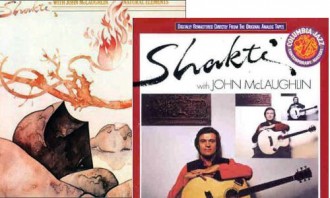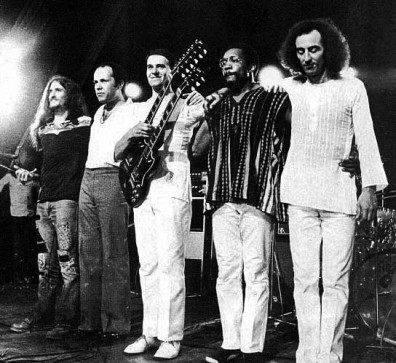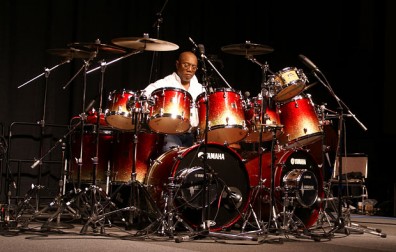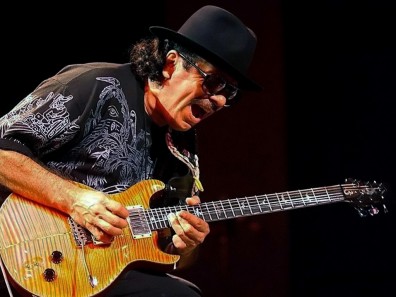John McLaughlin Remembers
Shakti
Early 1971: My fascination with Indian culture continues. I search for and find a Music Master from whom I can learn correctly and find Dr. S. Ramanathan who is teaching South Indian Music at the University of Connecticut. I become an ex-curricular student of his and begin learning Vina.
1972: While on the campus of the University of Connecticut during one of my days studying Vina, I am introduced to violinist Dr. L. Shankar, who teaching South Indian Music at the University of Connecticut.
1972: While on the campus of the University of Connecticut during one of my days studying Vina, I am introduced to Violinist Dr. L. Shankar, who is also teaching there. Later this year we play together at my home, and it is so fine that I speak to him about the possibility of he and I playing together with Zakir Hussain. The first idea of Shakti is born.I continue my studies with Dr. Ramanathan until the end of 1973. I then terminate my studies on Vina because I realize that I cannot play guitar and Vina. I continue my new association with L. Shankar, and Zakir. In addition, I become an ex-curricular student of Sitar Maestro Ravi Shankar. I learn more theory from North and South Indian music from Ravi Shankar. By this time I am speaking to guitar builder Mark Whitebook about my ideas for a ‘Shakti’ Guitar with a scalloped fingerboard and sympathetic strings. Ali Akbar Kahn tells me I need at least 7, so I want 7. Unfortunately Mark Whitebook has asthma, and has to quit building guitars, a real shame. On the first Shakti album I am playing one of his guitars. I find Abraham Wechter who is working for Gibson Guitars at this time, and he is the one who finally builds me a Shakti Guitar. It’s Great!
1974: I start to play small concerts with Zakir, L. Shankar and the percussionist from my Vina Master, Mridangam Maestro, Ramnad Raghavan.
This is truly the beginning of Shakti. December 1975: The first Shakti Album is recorded live at Southampton College in New York. It will be released shortly in the New Year, it will also be the first of many ‘live’ recordings to be made by Shakti. However, the other percussionist on the Southampton recording, (Dr. S. Ramanathan’s own accompanist, R. Raghavan) has too many obligations to be able to participate as a full time member of the new group.
I leave for India for the first time in my life. After so many years of association with its culture and philosophy, not to mention its musicians, I am really excited to go.
During this month I go to Madras (Chennai) to spend time with L. Shankar, and also to ind another percussionist to replace Raghavan. I am introduced to Ghatam player extraordinaire, T.H. (Vikku) Vinayakram. After hearing him play once I invite him to join Shakti. He accepts, and moves to New York.
The next years are a musical paradise for me. The only cloud in an otherwise clear blue sky is the general animosity I get from the agents and the radio stations who think I’m a little crazy to have abandoned a very successful ‘Electric Group’ such as the various ‘Mahavishnu’s’. Shakti begins a series of American and European Tours with ‘Weather Report.’ This is one of the greatest ‘Weather Report’ groups. It comprises, Wayne Shorter, Joe Zawinul, Jaco Pastorius, Alex Acuna and Manolo Badrena. In all the tours we did together, every night the musicians from ‘Weather Report’ would be on the side of the stage listening to Shakti, and for their show we would all be on the side of the stage listening to them. A marvelous period…
1978: ‘Vikku’ wishes more and more to return home to Madras, to his family and also he has a music school there, founded by his father and his presence is needed. After many years of very close musical collaboration, Shankar and I start drifting apart. He has gotten a record deal with Frank Zappa’s record label, but wants more and more to go the ‘pop’ way, instead of wishing to come closer to my ‘Jazz’ way.
1978: Spring. Shakti has been disbanded. ‘Vikku’ has returned to Madras and Shankar joins me in my next project, ‘The One Truth Band’, continues his experiments with pop music while continuing his classical career.
Mahavishnu
After a Club date with Miles Davis in Boston in 1970, Miles tells me that it’s time I formed my own band. If he says it, it must be true… In my mind, I begin the first conception of the ‘Mahavishnu Orchestra’. He also says ‘If you wanna make some money, go see Nat Weiss’. He gives me Nat’s phone number and a week later I sign a management contract with his company. Even though we don’t work together any longer, Nat Weiss remains till today my all time favorite manager. He also introduces me to Clive Davis who worked for CBS at the time. Clive Davis has got to be the greatest record man of the 20th Century.
For the 1st Mahavishnu, I invite drummer Billy Cobham who played with me on Miles favorite recording, ‘Jack Johnson’, I wanted a violinist probably thanks to my Mom, and I found Jerry Goodman from Chicago, pianist Jan Hammer and my old friend from the U.K. bassist Rick Laird.
February 1971: By the time we come together for the first time, I’ve got enough new music for two records. First public appearance, 2 weeks opposite John Lee Hooker at the ‘Whiskey A Go Go’ on Bleeker Street New York. Unbelievable success! We have to be the loudest and fastest group on the planet! 2 Days after the ‘Whiskey’ gig, we record ‘Inner Mounting Flame.’ Amazing successes follow. We win most of the ‘Downbeat’ Prizes by the end of the year. Grammy Nominations follow, etc..
By the end of 1973 the band ‘Mahavishnu Orchestra’ disbands due to discontent on the part of Jan Hammer and Jerry Goodman. 2nd. ‘Mahavishnu Orchestra’ is formed. It includes drummer Narada Michael Walden and bassist Ralphe Armstrong. A String Quartet and Brass are also part of this group. It’s big! 11 musicians… First recording with this formation is ‘Apocalypse’ produced by George Martin. We record with the London Symphony Orchestra conducted by Michael Tilson Thomas. What a team!!! A great experience. The group continues to enjoy great success through the end of 1974.
I am still playing big concerts with a reduced version of the Mahavishnu Orchestra, but the writing is on the wall for me. Before breaking the band, we record an album, and I use my first guitar synth. It’s a 360 Systems Interface that uses 6 MiniMoog Modules !!! It’s a monumental elephant, but I really love it. Unfortunately the technology is primitive. I’m going to have to wait… Musically, I want to devote my time to playing with Shakti, and leave Mahavishnu behind. I speak to both Zakir and L. Shankar about the idea of a ‘permanent’ Shakti group, and they are as enthusiastic as I am.
1986: I form another electric band with tenor sax man Bill Evans, keyboardist Mitch Forman, bassist Jonas Hellborg and drummer Danny Gottlieb. We record two Albums, ‘Mahavishnu’ and ‘Adventures in Radioland’. ‘Mahavishnu’ is again with Warner, bad news, it was a really great band. In addition I have discovered the Synclavier, and shortly after the interface for guitar. It’s heavy but I love it….I’ll have to wait again.
1987: I am obliged to break the band due to extremely ‘creative accounting’ after a long tour, which left me swimming in very deep red ink….
THE LOST TRIDENT SESSIONS
These recordings of the first Mahavishnu Orchestra took place at the Trident Studios in London with the great Ken Scott in charge of recording. The recordings actually took place during the year 1972 and not 1973 as written on the CD cover. I was personally very happy with these recordings, and was excited about the release of this record. However, all was not well during that year with the Mahavishnu Orchestra. Billy Cobham, Larry Young and I had made a record and a tour with Carlos Santana, Doug Rauch and Armando Peraza. The record went ‘Gold’ pretty quickly, the tour was a sellout, and all in all the project was a great success.
At the end of the Santana Tour in Hawaii, Billy and I caught a flight that the rest of Mahavishnu had taken from LA. We were on our way to Tokyo to begin our first Japanese tour. We boarded the flight and I knew right away something was wrong. Jan Hammer and Jerry Goodman wouldn’t speak to me. Rick Laird was still cool and of course, Billy and me were tight, we had just finished a great tour. To make a long story short, Jan and Jerry refused to speak with me and after a week of this treatment I let them know that I couldn’t play music with people who didn’t want to speak with me. They didn’t care and six months later that great band was history. I still don’t know today, 30 years later, why they went ‘out’ like that, but anyway, they then began making unhappy noises to our to our manager about the release of the Trident Recordings.
I wanted to be democratic about it and I put it to the vote. Billy and I wanted an immediate release. For some reason Jan and Jerry convinced bassist Rick Laird to vote with the both of them against not only an immediate release, but they didn’t want to release the album at all, so consequently the recordings stayed in CBS and eventually got lost. We recorded the live album ‘Between Nothingness and Eternity’ in a Central Park concert to replace the Trident recordings. After all these years I really am happy to finally see these recordings released. I’d like to add at this point that inspite of the wierdness of this story, I still have great affection for all of the guys in the first Mahavishnu. That was some band !
|
|
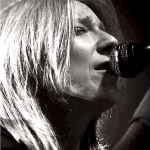
|
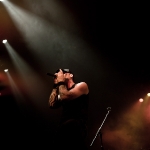
Soil |
LATEST GALLERY IMAGES
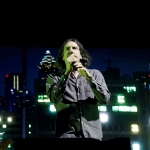
Snow Patrol 2025 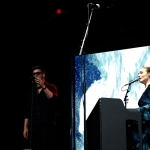
Freya Ridings 2025 |
|
|


